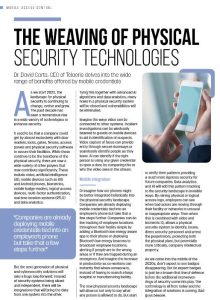
As we start 2022, the landscape for physical security is continuing to change, evolve and grow. The past decade has seen a tremendous rise in a wide variety of technologies to enhance security.
It used to be that a company could get by almost exclusively with door readers, locks, gates, fences, access panels, and physical security software to secure their facilities. While these continue to be the backbone of the physical security, there are now a wide variety of other players that now contribute significantly. These include video, artificial intelligence (AI), mobile devices such as iOS and Android phones, biometrics, mobile badge readers, logical access devices, multi-factor authentication, real time location systems (RTLS), and data analytics.
But the next generation of physical and cyber security solutions will take a huge leap forward. Instead of security systems being siloed and independent, there will be integrations that will bring the data from one system into the other. Tying this together with advanced AI algorithms and data analytics, many holes in a physical security system will be closed and vulnerabilities will be eliminated.
Imagine the ways video can be connected to other systems. Incident investigations can be wirelessly beamed to guards on mobile devices to guards to aid in identification of suspects. Video capture of faces can provide entry through secure doorways or seamlessly identify people as they leave. AI can identify if the right person is using any given credential to open a door, by comparing this to who the video sees in the stream.
Or imagine how our phones might be better integrated holistically into the physical security landscape. Companies are already deploying mobile credentials tied into an employee’s phone, but take that a few steps further. Companies can do live tracking of employee locations throughout their facility simply by adding a Bluetooth low energy aware app to their phone or deploying Bluetooth low energy beacons to broadcast employee locations, alerting if people are in the wrong areas or if they are trapped during an emergency. And imagine the increase in productivity as co-workers can instantly find where someone is, instead of having to search a large hospital or manufacturing facility.
The new physical security landscape will allow us not only to say is what any person is allowed to do, but start to verify their patterns providing a much more rigorous security for future companies. Data analytics and AI will add this pattern tracking to the security landscape in invisible ways. By mining physical or logical access logs, employers can see when bad actors are moving through their facility or networks in unusual or inappropriate ways. Then when this is combined with video and biometric ID, allows a physical security system to identify, locate, direct security personnel, and arrest the perpetrators, protecting both the physical plant, but potentially more critically, company intellectual property.
As we come into the middle of the 2020s, don’t expect to see badges disappearing. But do expect badges to just be a known first line of defense, before the additional interwoven rings of security come into play. The technology is all here today and the integration of solutions is coming. Bad guys beware!
CLICK HERE to see on internationalsecurityjournal.com.
